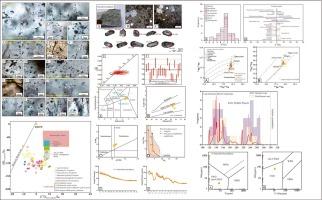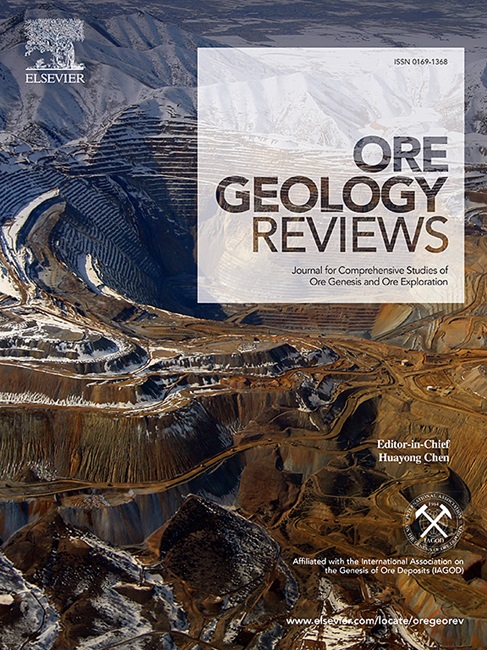中国东北大兴安岭南部莲花山铜矿床的形成:流体包裹体、全岩地球化学、锆石U-Pb地质年代和H-O-S-Pb同位素的制约因素
IF 3.2
2区 地球科学
Q1 GEOLOGY
引用次数: 0
摘要
中型莲花山硫化铜矿床位于中国东北部内蒙古兴安岭南部。带状块状硫化物矿脉主要赋存于二叠系大石寨地层中,矿脉受 NW-NNW 走向构造控制。成矿过程包括四个阶段:砷黄铁矿-石英(I);黄铜矿-黄铁矿-石英(II);黄铁矿-黄铜矿-闪锌矿-方铅矿-石英(III);矿石-硫化物-石英-碳酸盐(IV)。流体包裹体有三种类型,即富含蒸汽的两相(LV 型)、富含液体的两相(VL 型)和含子矿物的三相(SL 型)。第一、第二和第三阶段包含所有类型的 FIs(LV 型、VL 型和 SL 型),均化温度(Th)分别为 268-462°C、230-382°C 和 180-340°C,盐度分别为 3.4-52.3、3.4-44.5 和 3.7-39.9 wt% NaCl 当量,而第四阶段只有 VL 型 FIs,Th = 152-232°C,盐度 = 3.4-7.9 wt%。流体地球化学数据表明,莲花山矿石流体具有中高温(236-382 °C)、高盐度(31.5-44.5 wt%)和相对氧化的条件,是典型的 NaCl-H2O 体系。微测温和 H-O 同位素数据(δ18OH2O = - 9.0 至 6.1 ‰;δD = - 149.0 至 - 99.0 ‰)表明,矿石流体最初是岩浆流体,后来有陨石水侵入。硫化物 S(δ34S = - 2.9-3.8 ‰)和 Pb(206Pb/204Pb = 17.954 - 18.492,207Pb/204Pb = 15.427 - 15.739,208Pb/ 204Pb = 37.815 - 38.357)同位素支持金属来源于岩浆。流体沸腾、冷却和陨水混合可能是莲花山矿石沉淀的主要机制。对于成矿花岗斑岩(锆石 U-Pb 年龄:252.8 ± 1.8 Ma),地球化学数据表明,原生岩浆是由增厚或分层的下地壳部分熔融形成的。综合现有的年龄、地质和地球化学证据,我们认为莲花山的矿化在时空和基因上与花岗斑岩斑岩有关,是在古亚洲洋关闭后的火山弧环境中形成的。本文章由计算机程序翻译,如有差异,请以英文原文为准。

Formation of the Lianhuashan Cu deposit in the southern Great Xing’an Range, NE China: Constraints from fluid inclusions, whole-rock geochemistry, zircon U–Pb geochronology, and H–O–S–Pb isotopes
The medium-sized Lianhuashan Cu sulfide deposit is located in the southern Xing’an Range of Inner Mongolia, NE China. The zoned massive sulfide vein ores are hosted mainly in the Permian Dashizhai Formation, and the ore veins are controlled by NW–NNW-trending structures. The ore-forming process comprises four stages: arsenopyrite–quartz (I); chalcopyrite–pyrite–quartz (II); pyrite–chalcopyrite–sphalerite–galena–quartz (III); and ore-barren sulfide–quartz–carbonate (IV). Three types of fluid inclusions (FIs), namely vapor-rich two-phase (LV-type), liquid-rich two-phase (VL-type), and daughter mineral-bearing three-phase (SL-type), are distinguished. Stage I, II and III contain all types of FIs (LV-, VL-, and SL-type), with homogenization temperatures (Th) of 268–462°C, 230–382°C and 180–340°C and salinities of 3.4–52.3, 3.4–44.5 and 3.7–39.9 wt% NaCl eqv., respectively, whereas stage IV has only VL-type FIs, with Th = 152–232°C and salinity = 3.4–7.9 wt%. Fluid geochemical data show that the Lianhuashan ore fluids were of medium–high temperature (236–382 °C), high-salinity (31.5–44.5 wt%), and relatively oxidizing conditions, typical of a NaCl-H2O system. The microthermometric and H–O isotope data (δ18OH2O = − 9.0 to 6.1 ‰; δD = − 149.0 to − 99.0 ‰) indicate that the ore fluids were initially magmatic with later meteoric water incursion. The sulfide S (δ34S = − 2.9–3.8 ‰) and Pb (206Pb/204Pb = 17.954 − 18.492, 207Pb/204Pb = 15.427 − 15.739, 208Pb/ 204Pb = 37.815 − 38.357) isotopes support that the metals were magmatic-derived. Fluid boiling, cooling, and meteoric water mixing were likely the main ore precipitation mechanism at Lianhuashan.
We suggest that Cu minerals at Lianhuashan were precipitated with boiling at ∼ 1 km depth. For the ore-forming granodiorite porphyry (zircon U-Pb age: 252.8 ± 1.8 Ma), geochemical data indicate that the primary magma was formed by partial melting of the thickened or delaminated lower crust. Integrating the available age, geological, and geochemical evidence, we suggest that mineralization at Lianhuashan is spatial–temporal and genetically associated with the granodiorite porphyry, and was formed in a volcanic arc setting after the Paleo-Asian Ocean closure.
求助全文
通过发布文献求助,成功后即可免费获取论文全文。
去求助
来源期刊

Ore Geology Reviews
地学-地质学
CiteScore
6.50
自引率
27.30%
发文量
546
审稿时长
22.9 weeks
期刊介绍:
Ore Geology Reviews aims to familiarize all earth scientists with recent advances in a number of interconnected disciplines related to the study of, and search for, ore deposits. The reviews range from brief to longer contributions, but the journal preferentially publishes manuscripts that fill the niche between the commonly shorter journal articles and the comprehensive book coverages, and thus has a special appeal to many authors and readers.
 求助内容:
求助内容: 应助结果提醒方式:
应助结果提醒方式:


